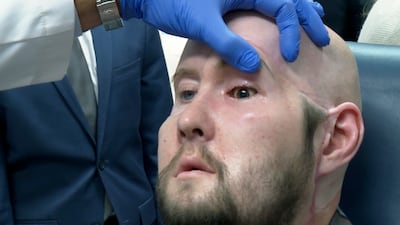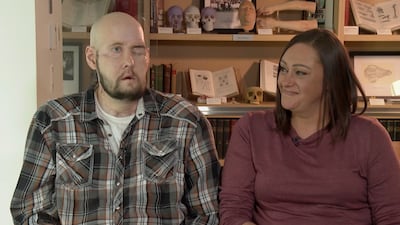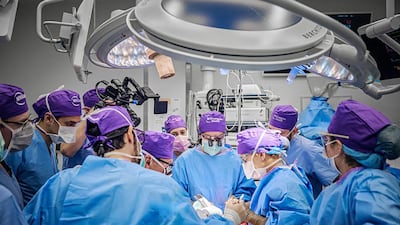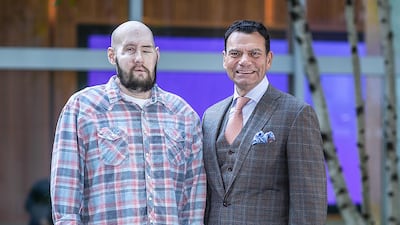The world’s first whole-eye replacement and partial-face transplant has been performed on a US military veteran who lost his arm and suffered severe facial injuries in a high-voltage electrical accident.
Aaron James, 46, from Arkansas, was working on power lines when his face accidentally touched a live 7,200-volt wire, causing extensive damage.
A surgical team from NYU Langone Health in New York has transformed Mr James’s appearance after he suffered devastating injuries to his left eye and left arm, his entire nose and lips, front teeth, left cheek area, and chin down to the bone.
Remarkably, not only have surgeons been able to reconstruct his face, they hope his sight can be restored as blood flow is beginning to return to his retina, six months after the initial 21-hour procedure.
NYU Langone Health
“Aaron has been extremely motivated to regain the function and independence he lost after his injury,” said Dr Eduardo Rodriguez, who is director of NYU Langone Health's face transplant programme.
“We couldn’t have asked for a more perfect patient.
“This achievement demonstrates our capacity to embrace the most difficult challenges and drive continuous advancements in the field of transplantation and beyond.”
The medical team at NYU Langone took on the case two months after the accident in June 2021 during early facial reconstruction work at a Texas medical centre where Mr James was being treated.
Surgeons had to remove his left eye, due to severe pain. They severed the optic nerve as close to the eyeball as possible to maximise the chance of a successful eye transplant.
Recovery signs
The transplanted left eye has shown signs of health, including direct blood flow to the retina – the area at the back of the eye that receives light and sends images to the brain.
“Given Aaron needed a face transplant and will be taking immunosuppressive drugs regardless, the risk-versus-reward ratio of transplanting the eye was very low,” said Dr Rodriguez.
“The mere fact that we’ve accomplished the first successful whole-eye transplant with a face is a tremendous feat many have long thought was not possible.
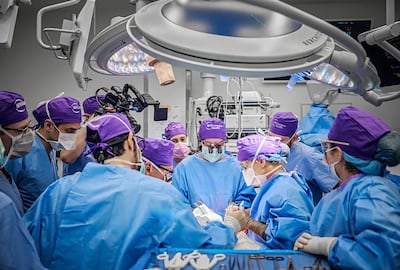
“We’ve made one major step forward and have paved the way for the next chapter to restore vision.”
Although corneal transplants are relatively common, with thousands performed in the US each year, successful whole-eye transplants to restore vision have remained elusive due to the complex nature of the organ.
The challenges include nerve regeneration, immune rejection, and retinal blood flow.
As the eye is intricately connected to the brain through the optic nerve, which is part of the central nervous system and responsible for transmitting visual information to the brain, it is a complex procedure.
Re-establishing these nerve connections successfully is a fundamental requirement for a whole-eye transplant to restore vision and one of the biggest challenges.
Mr James was on the transplant waiting list for just three months before a suitable donor was found in New York.
“The donor hero was a young man in his thirties who came from a family that strongly supports organ donation,” said Leonard Achan, chief executive of LiveOnNY, the organ procurement organisation for the greater New York metropolitan area.
“He … donated tissues leading to this successful face and eye transplant, but also saved three other individuals between the ages of 20 and 70, donating his kidneys, liver, and pancreas.”
3D-printed face
A 3D-printed replacement of the donor’s face was created to restore the integrity of the donor’s identity after the organs were removed.
Meanwhile, adult stem cells were injected into Mr James's optic nerve to maximise the chances of success.
Transplanted stem cells can work as a replacement therapy and natural repair crew, creating heathy cells that replace the damaged or dysfunctional elements of the eye.
It is hoped the groundbreaking achievement can open up new possibilities for future advancements in vision therapies and related medical fields.
The world’s first face transplant was performed in France in 2005 on a woman called Isabelle Diniore who was mauled by a dog. She died 11 years after the surgery in 2016, aged 49.
The youngest recipient of a replacement face was Katie Stubblefield, 21, who survived an attempted suicide aged 18, while the oldest was a 64-year-old Canadian man who was given a face transplant at Montreal's Maisonneuve-Rosemont hospital after a shooting accident.
